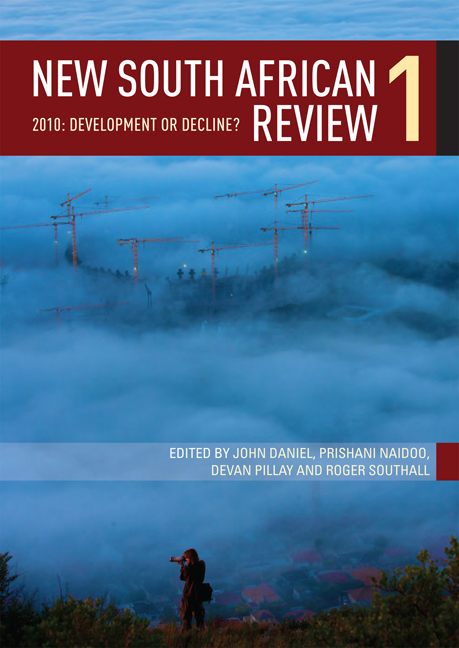Book contents
- Frontmatter
- Contents
- Preface
- Introduction South Africa 2010: From short-term success to long-term decline?
- PART 1 ECONOMY, ECOLOGY AND SUSTAINABILITY
- PART 2 STATE, POLITICS AND POLICY
- PART 3 EDUCATION, HEALTH AND LAND
- INTRODUCTION Reform and redress in higher education, health and land
- CHAPTER 11 ‘Silencing and worse …‘: The humanities and social sciences in South Africa
- CHAPTER 12 Realising transformation, equity and social justice in higher education
- CHAPTER 13 The polarising impact of South Africa's AIDS epidemic
- CHAPTER 14 Health for all? Towards a national health service in South Africa
- CHAPTER 15 The Comprehensive Rural Development Programme (CRDP): A beacon of growth for rural South Africa?
- CHAPTER 16 Breaking down barriers: Policy gaps and new options in South African land reform
- PART 4 Doreen Atkinson
- Contributors
- Index
CHAPTER 12 - Realising transformation, equity and social justice in higher education
from PART 3 - EDUCATION, HEALTH AND LAND
Published online by Cambridge University Press: 21 April 2018
- Frontmatter
- Contents
- Preface
- Introduction South Africa 2010: From short-term success to long-term decline?
- PART 1 ECONOMY, ECOLOGY AND SUSTAINABILITY
- PART 2 STATE, POLITICS AND POLICY
- PART 3 EDUCATION, HEALTH AND LAND
- INTRODUCTION Reform and redress in higher education, health and land
- CHAPTER 11 ‘Silencing and worse …‘: The humanities and social sciences in South Africa
- CHAPTER 12 Realising transformation, equity and social justice in higher education
- CHAPTER 13 The polarising impact of South Africa's AIDS epidemic
- CHAPTER 14 Health for all? Towards a national health service in South Africa
- CHAPTER 15 The Comprehensive Rural Development Programme (CRDP): A beacon of growth for rural South Africa?
- CHAPTER 16 Breaking down barriers: Policy gaps and new options in South African land reform
- PART 4 Doreen Atkinson
- Contributors
- Index
Summary
South Africa has come from an unequal past in which higher education institutions were designed to confer privilege upon a minority of the population identified through social signifie rs of race, gender, and language – an inequality affecting students (how, where and what they could study), staff (who could become academics, administrators and service workers, where and to what occupational level they could ascend); and governance (how institutions were governed and who governed them).
Since 1994, the higher education sector has been moulded in three principal ways. First, through restructuring, whereby institutions were rationalised and merged to make a more coherent higher education system; second, through transformation to render the sector more accessible, equitable, representative and socially responsive; and third, through the implementation of managerial and market logic, corporate efficiency and global competitiveness. The operation of these three processes has often proved to be contradictory, and higher education institutions and their constituencies have found themselves confronting constant crises.
This overview seeks to examine how the sector has fared in terms of transformation, equity and social justice. It acknowledges criticisms that the visionary and expansive nature of transformation as envisaged in the Education White Paper 3 of 1997 has been replaced in practice by a limited focus on equity statistics to gauge student and staff transformation. Jansen (1998 and 2004) has criticised this approach as seldom amounting to more than ‘racial accounting’, while others (Erasmus 2010 and 2008; Habib 2004) have pondered the complexities of continuing to use apartheid categories as indicators to measure post-apartheid change. Nonetheless, the utilisation of equity statistics continues to be a powerful tool, and it is within this light that this chapter uses statistics on student and staff transformation as a proxy for determining progress. An attempt is made here to reflect on both student and staff transformation with the aim of drawing meaningful connections between them.
The chapter relies principally upon data drawn from the Department of Education's Higher Education Management Information Systems (HEMIS). Student data is largely extracted in an already collated format from the South African Survey and various reports of the Council for Higher Education (CHE), while staff data is largely derived from previous work done by the author.
- Type
- Chapter
- Information
- New South African Review2010: Development or Decline?, pp. 281 - 304Publisher: Wits University PressPrint publication year: 2010

